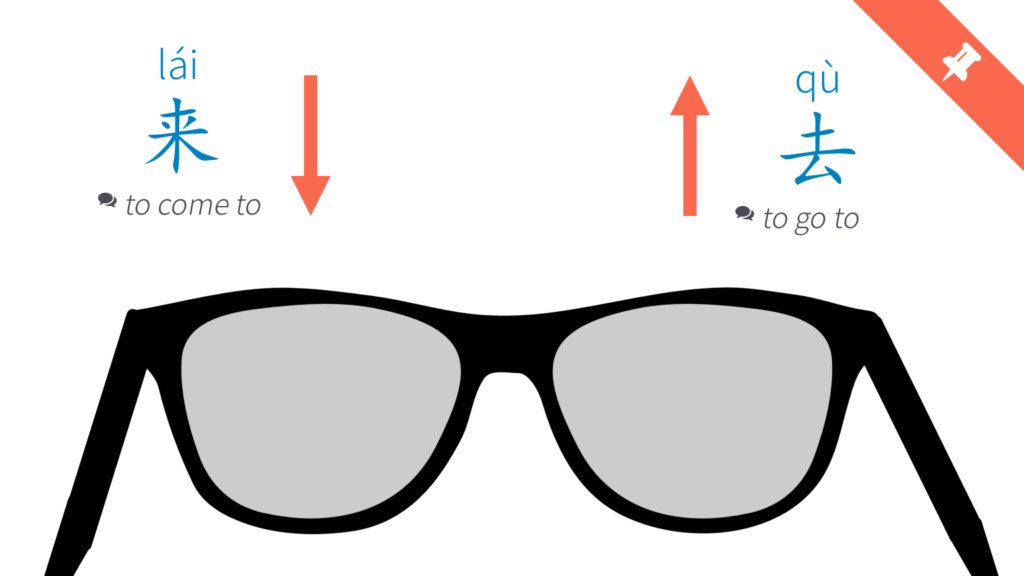Level 1 Lesson 21.1 – I Go Eat Pizza with My Boyfriend in A Restaurant

To Do Something With Someone in Chinese with 和 | 来 vs. 去 vs. 回 in Chinese
In this video lesson we'll learn a very useful verb that means to come to in Chinese: 来. And we'll also learn the usage of Preposition 和, which can be used to say to do something with someone in Chinese.
- To come to in Chinese: 来
- To do something with someone in Chinese with 和
- 来 vs. 去 vs. 回 in Chinese
- Sentence Word Order in Chinese: Subject + Time Word + Place + Prepositional Phrase + Verb + Object
VOCABULARY
GRAMMAR
Grammar 1: To come to in Chinese: 来 · HSK 1
Today we have a very useful verb - to come to in Chinese: 来 lái. 来 suggest that the direction of traveling is coming towards where we are.
We can use 来 with this structure:
Subject + 来 + Place
For example:
- tā jīntiān xiǎng lái wǒ jiā
他今天想来我家。
he wants to come to my house today - nǐ shénme shíhou lái Zhōngguó lǚyóu
你什么时候来中国旅游?
when (are) you com(ing) to China to travel - Zhāng Lǎoshī xiàge xīngqī bù lái shàngbān
张老师下个星期不来上班。
teacher Zhang (is) not com(ing) to work next week
Grammar 2: Compare Verb 来 vs. 去 vs. 回 in Chinese · HSK 1
In Lesson 16 and Lesson 17 we learned the verb qu 去 and the verb huí 回 in Chinese. Lái 来 is similar with them, all three of them indicating direction of travelling.
去 and 来 have the opposite meaning with each other. So they are a pair of Fányìcí 反义词, Antonyms. Qù 去 mean to go or to go to some place, while 来 mean to come or to come to this place.
As shown in the picture below, if this is your point of view, anyone coming towards you, is 来, to come, and when you are going away from where you are is 去, to go.

And with huí 回, we do not know whether it is to come back or to go back, it could mean either one of them.
Grammar 3: To do something with someone in Chinese with 和 · HSK 1
We have learned hé 和 as a Conjunction in Lesson 20, in today's lesson we'll learn how to use 和 as a Preposition so that we can say to do something with someone in Chinese with 和.
We can follow this structure:
Subject + 和Object1 + Verb Predicate (+ Object2)
For example:
- wǒ hé wǒde nǚpéngyou qù fànguǎn chī pīsà
我和我的女朋友去饭馆吃披萨。
I go to the restaurant to eat pizza with my girlfriend - tā jīntiān hé nǎn péngyou lái wǒjiā zuò jiǎozi gěiwǒ chī
她今天和男朋友来我家做饺子给我吃。
today she comes to my home with her boyfriend to make dumplings for me to eat - wǒmen jīntiān zài xuéxiào hé Xiè Lǎoshī hē kāfēi
我们今天在学校和谢老师喝咖啡。
we drank coffee with Teacher Xie at school today
Grammar 4: Sentence Word Order in Chinese · HSK
If a sentence has a lot of information, it has the Subject, Time, Place, other Prepositional Phrase, A Verb Predicate and its Object, the sentence word order can go like this:
Subject + Time Word + Place + Prepositional Phrase + Verb + Object
For example:
- tā zuótiān zài fànguǎn hé nǚpéngyou chī pīsà
他昨天在饭馆和女朋友吃披萨。
He yesterday at restaurant with girlfriend eat pizza - Zhāng Lǎoshī jīntiān zàijiā hé Xiè Lǎoshī kàn diànyǐng
张老师今天在家和谢老师看电影。
Teacher Zhang today at home with Teacher Xie watches movie.
I have a question about sentence structure using 和:
I think the first example is what you are teaching:
1. 我今天在家和你吃饭。
subject _time_place_和 etc
Are the two examples below also acceptable or incorrect?
2. 我今天和你在家吃饭。
3. 我和你今天在家吃饭。
one question: 他想和你看电影 we put 想 before 和。 But in the other sentence: 他今天和女朋友来吃饭 we put the verb 来 NOT before the 和. can you explain me the difference? Many thanks
不好意思,我有一个问题,我不能看看这个视频。我不知道为什么。你能不能帮我吗,谢谢您
我早上在学校和我的同学和水。
喝水?